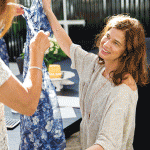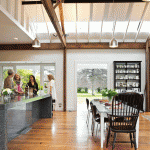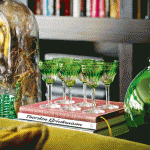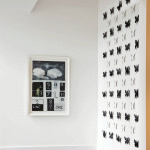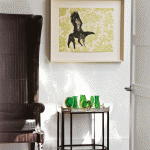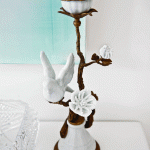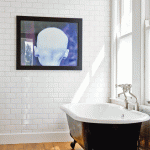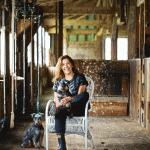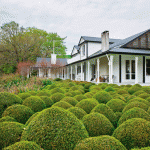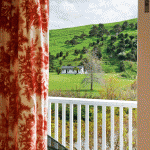Life on the run: keeping up with businesswoman Liz Stringer
- The red art work, by South Koren Sea Hyun Lee, takes up an entire wall. It depicts what he saw using night-vision goggles while completing his military service. “Apparently the goggles coated everything in red. I just loved it, the scale of it,” says Liz. “It was just a gut feeling that drew me to it.” Behind her, the “mad Murano glass candelabra” is one of two Liz had shipped to New Zealand in parts and reassembled.
- Liz will try on her When Harry Ran Away designs to see how they fit for size. “I’m always the medium, whatever size I am, so our medium can be a little fluid.” Her manager, Wendy Croskery (above), is a huge help. “When I was talking about opening Harry’s, lots of people said, ‘Oh, you’ll want Wendy as your manager.’”
- While Liz and Rob spend a lot of quiet time at the farm, they also frequently have crowds of company for cricket (including an annual Winemakers v Old Tablelands XI), parties and family occasions. “We’re expecting 30 for Christmas. We basically use any excuse for a party and can often have 20 staying overnight.” When Liz bought the shelves behind the kitchen table “I thought, ‘Well, I’d better fill them’, so I drove around Wairarapa looking for things to fill them and came home with a lot of white jugs.”
- Liz’s study is where she relaxes. “The sofa was especially made so it’s more comfortable to lie on than sit on.”
- Along with her green glass, Liz is a dedicated collector of crystal. In the bedroom, a mid-century glass cocktail trolley is crowded with antique silver-topped perfume bottles. “I collect crystal wherever I see it. A lot is picked up from Sue Todd Antiques in Dunedin when I’m there helping my kids settle into – or clear out of – student flats. I’ll pop in and shout myself a few pieces as a treat.”
- Reflecting Liz’s favourite colours is her Raymond McIntyre 1913 portrait (on the console, bottom left) called Harmony in Black, Green and White, a very knowing gift from Rob.
- For dinner parties, Liz tends to move into the formal dining room (right), using the huge table she may (just quietly) have danced on, ducking under the crystal chandeliers.
- Elizabeth Thompson’s art work of hand-painted bronze moths (below left) is a favourite. “Why? They’re black and white. I saw them at the City Gallery [in Wellington] and had to have them. We take all our family photos in front of the moths – somehow it just works as a background. Elizabeth and her husband came and hung these. It took two days.”
- The sofa in the hall, which Liz calls the “bus stop”, is Italian and covered in patent eel skin. It was originally decorated with feathers “but the dogs ate them while we were away one day”.
- The photograph under the stairs is a self-portrait from a German photographer.
- The Fornasetti plates, in daughter Alex’s old room, are Italian.
- The farm gives Liz even more room to display her beloved crystal and art, including work by Bill Hammond.
- Anne Noble in the bathroom.
- Moving into the wide open spaces at Old Tablelands presented a bit of a culture shock for the family, once so at home in the urban metropolis of Hong Kong – and none more so than dogs, Ollie (10) and Angus (12). “You should have seen them the first time they came to the farm. We have a full-sized cricket pitch here, so it’s massive. They stood there and they looked at all that grass and went, ‘Hell no, I’m not going out on that.’ Now they roar off and run around.”
- At the Martinborough farm, the topiary were grown from root trainers about 15 years ago and replanted into a meandering, “slightly mad” mini forest. “I told Kim, who clips them, I wanted it to look like a Henry Moore sculpture. That hasn’t quite happened, but I love that whimsical Alice in Wonderland look. It’s like a Victorian pleasure garden.”
- ‘We did aim for 50 per cent of our time at the farm this year – we will get there. When I get to the country, I breathe out’
- The building in the distance is the guest cottage, viewed across the cricket pitch.
For a woman who really loves black and white, Wellington businesswoman Liz Stringer lives a most colourful life, split between town and country.
WORDS: Lee-Anne Duncan Photos: Tessa Chrisp
This article was first published in the November/December 2016 issue of NZ Life & Leisure.
A wheeled rack of colourful clothes stands beside Liz Stringer’s capacious dining table. The shirts and dresses hanging in their various sizes are samples, facsimiles of Liz’s latest designs, which she’s packing for China.
The fabrics are already glorious but they might as well be calico. Once in China, Liz and her long-time tailor will visit a vast warehouse to hand pick fabrics to complete her next When Harry Ran Away range. The label is just a portion of the “affordable luxury” local and international brands carried at her two Harry’s boutiques, in Seatoun and Wellington’s CBD.

On the table is a pile of plastic bags for each set of clothes and small sacks stuffed with pips (tags) for the various sizes and for When Harry Ran Away. “I always pack everything in exactly the same place so I know I have everything,” says Liz, demonstrating their positions in her well-used Prada shoulder bag. “Imagine if I got all the way to China and I’d forgotten the pips.”
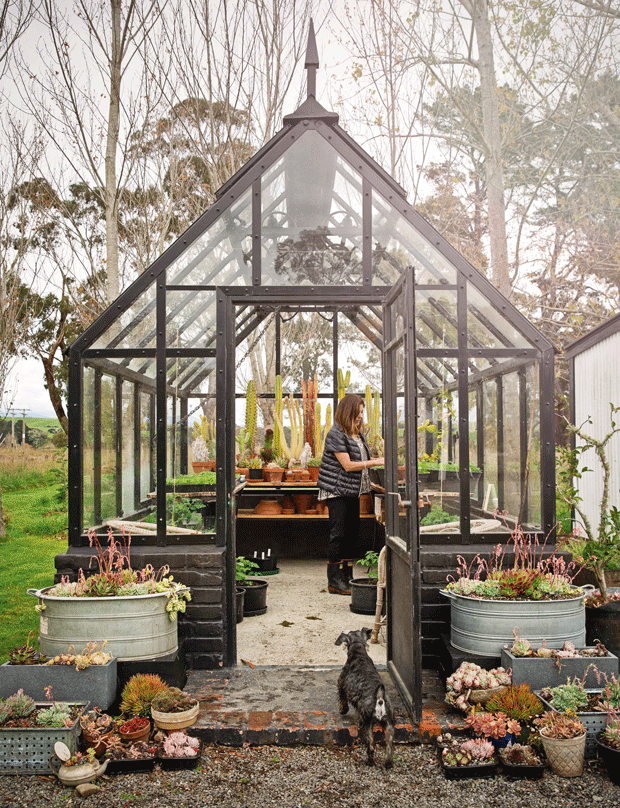
Gardening has always been Liz’s main creative outlet and it was her inability to garden in the concrete jungle of Hong Kong, where she used to live, that prompted her to throw her creativity into clothing. Now on her Martinborough farm with dog Angus, Liz can garden as much as she likes, including in the glasshouse hand made by a former gardener. Many of the succulents were driven up from her grandmother’s garden in Geraldine. “Some of them are 50 years old and still in their original pots. I was very close to my grandmother so it’s lovely having them with me.”
Liz’s speech is punctuated with exclamations and hoots of laughter. It’s indicative of the energy the businesswoman, fashion designer, traveler, gardener, conservationist and mother of three needs to keep to her schedule. It’s a timetable that’s about to take her to Auckland to meet with Harry’s suppliers, followed by a day back in Wellington, before this girl from Geraldine picks up her passport to travel to London, Italy, and Chamonix for a walking tour around Mont Blanc with close friends.

Much of Harry’s business is still centered around Liz’s dining table, where it all started.
“Eight women, born in six different countries, sleeping in one dormitory each night. We cover about 140 kilometres in seven days, walking more than three 2500-metre passes. It’s one of those life experiences.”
It will act as relaxation after her buying trip to Hong Kong and China. “China is mayhem. I literally hold each sample in my hand, one at a time, and walk around the fabric warehouse choosing the five different fabrics to make the piece in. I only ever make six garments across four sizes in the same fabric, so customers can have something exclusive and special.”

The farm’s “front room” is the only room Liz believes is truly finished. “I came in here one day, straightened everything up, and thought, ‘It’s finished – if I added anything it wouldn’t be right.’ It was a nice feeling, as I never seem to finish a room. The art work is by Auckland artist Max Gimblett.
Alongside is her trusted tailor, “arguing loudly in Mandarin”, who’s been making Liz’s clothes for the past 12 years in her small, family-run workshop. The relationship started when Liz lived in Hong Kong with husband Rob Morrison and children Alex, Hettie and Hugh, now aged between 20 and 24.
Liz is the first to admit she can’t even sew on a button (really), but as she couldn’t garden in Hong Kong she needed some creative outlet so started designing clothes for the tailor to make up. When the family moved back to Wellington in December 2008, Liz wanted to keep designing clothes but her own wardrobe was bursting.
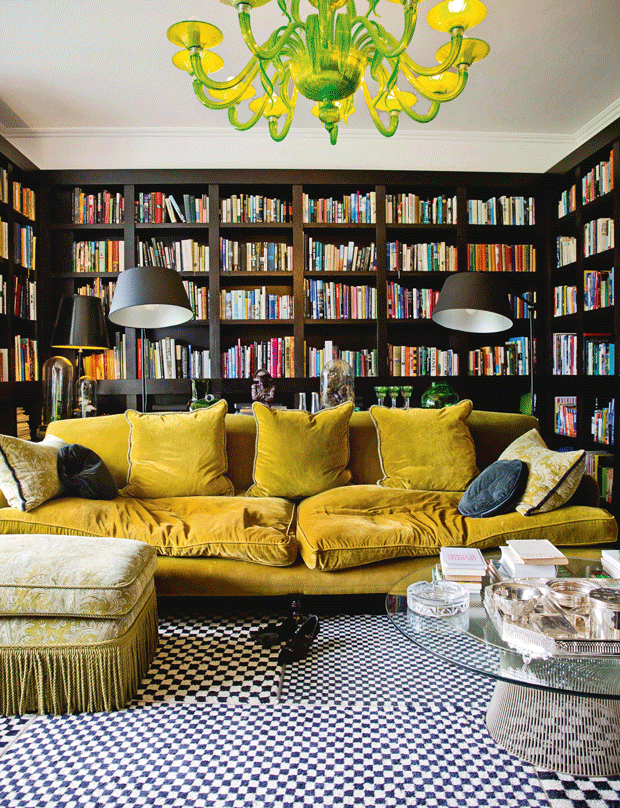
Liz loves her black and white, but green glass is another favourite. “It has to be exactly the right shade of green, and preferably mid-century Murano.”
“I actually don’t know what the thought process about opening Harry’s was. I just get a thought, an idea, and I do it. And I thought I’d open a shop. I loved going to China and making stuff, so I thought I’d buy clothes for other people. Which I have to say is just as much fun, if not more fun. You see them trying clothes on, looking at themselves in the mirror, and you see their faces just light up. It’s so nice.”
Harry’s opened in Seatoun a mere six months or so after Liz got that idea. It’s named for the family’s beloved black lab, whose ashes are pride of place at the shop, and is a quick stroll from Liz and Rob’s city house. Then, this July, a second store opened in Wellington’s CBD – a whirlwind 10 weeks after Liz got the notion to open.

When the premises became available, she followed her gut and signed up, hoping like heck the stock would land in time. “It was the usual Harry’s situation… we laughed it could turn to custard very quickly. But everyone scurried around and got it done – I have the most fabulous staff. There was a hell of a lot of clothes steaming going on.”
While the family’s move to Hong Kong was for Rob’s finance job, Liz also worked in finance back in the day, spending three years in the BNZ dealing room. But her training is in psychology. “I’d finished my Masters of Psychology at Canterbury and Robbie and I had moved to Wellington, so I’d started a PhD at Victoria. Then, for some unknown reason, I decided to go into finance. I didn’t even know what the CPI was. The timing was terrible – it was straight after the 1987 crash.”
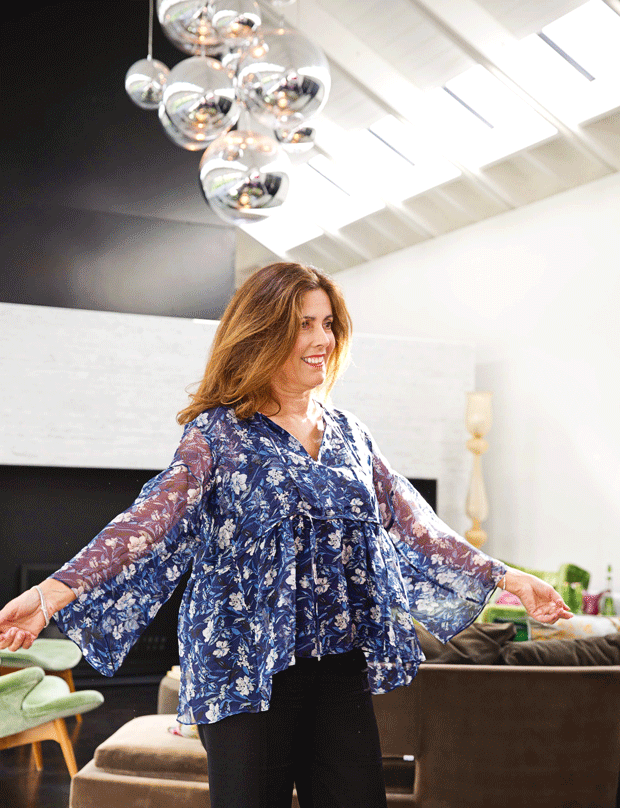
‘I love buying clothes for other people. You see them trying clothes on, looking at themselves in the mirror, and you see their face just light up. It’s so nice’
When she became pregnant with Alex, her eldest, her focus turned to motherhood. “I still put ‘mother’ down when I travel – I still feel that’s my occupation,” Liz says. However, when the family lived in Hong Kong, her children believed their mother’s occupation was actually “triathlete”.
“Not many people think of Hong Kong as being outdoorsy, but it was gorgeous there, my girlfriends and I would go out training at eight most mornings. We’d train for hours, then each would go home, shower change, get into high heels (depending on how sore the knees were) and make up, and we’d meet for lunch, champagne and shopping. It was a crazy lifestyle.”

It was the type of lifestyle that allowed her to claim the title of Hong Kong’s Veteran Woman’s Champion, complete four triathlons in Phuket, a Half Iron Man in Hawaii twice, climb to Mt Everest’s Base Camp and knock off Borneo’s Mt Kinabalu and Tanzania’s Mt Kilimanjaro.
However, a year ago she slowed from a run to a walk when her knee went in rather dramatic style, just as she was training for three days of half marathons in Mongolia. “I ripped it from the meniscus. And I’ve done both. I cried every day for a month because I knew I’d never run again. But – and here’s what I love about our lovely, lovely Harry’s clients – I’d picked myself up and was standing there with one foot up, and this car pulled over and it was this gorgeous client. She very kindly took me home.”
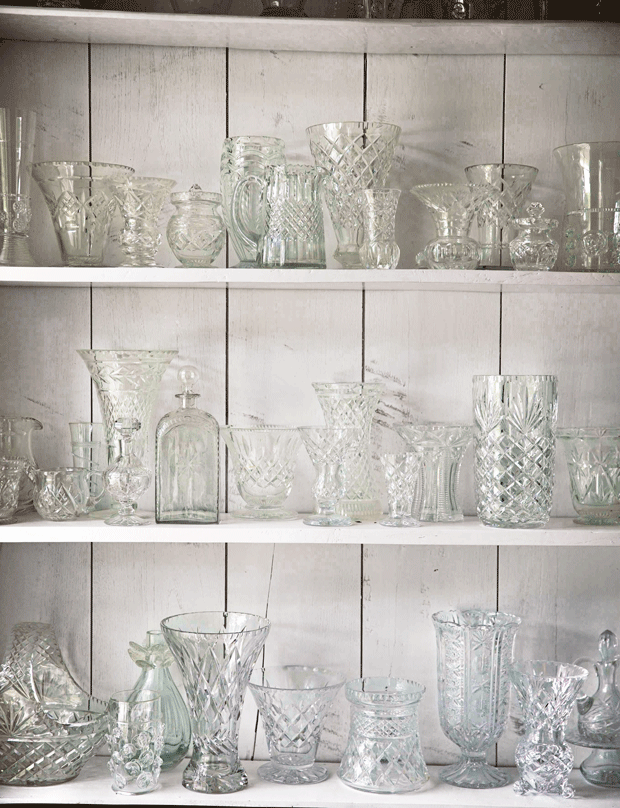
Pieces from Liz’s crystal collection.
Liz still went to Mongolia, keeping the campfires burning while Rob ran. But, being the woman she is, feeling her knee starting to feel better (or less sore), she thought she’d give the last day a go.
“I thought ‘it’s only 20 kilometres I can do this.’ So dumb – in the middle of Mongolia? By the end of it I was hobbling so much an older woman came past me and offered me her poles.”
As a counterpoint to all the running, walking, traveling, designing, buying and selling, Liz and Rob have their Martinborough farm. The 70-hectare property is the old Riddiford homestead, Old Tablelands, which they bought 16 years ago. Since then they’ve renovated the homestead and, while three paddocks are left in pasture for their cattle, the rest of the farmland has been gradually and painstakingly planted out in natives.
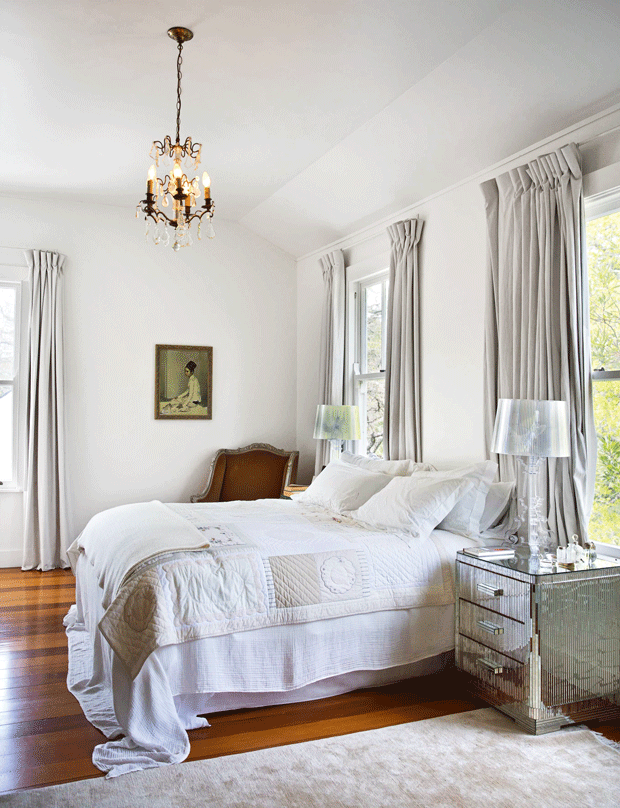
The bed’s quilt was hand made by Rob’s sister, from old family-owned and collected dollies and linen. “It’s absolutely stunning,” says Liz. “I’m very careful with it.”
“We put in about 6000 trees a year,” says Liz. “We have fantastic gardeners, and the kids get involved, as well as their friends.” But while native trees are going in, exotic pests are coming out. Liz and Rob are dedicated to pest eradication and conduct a thorough possum-trapping programme on their farmland. They also give their time to the Moa Conservation Trust and can be found of a weekend
tramping around the Rimutaka Range, jettisoning dead possums and resetting traps.
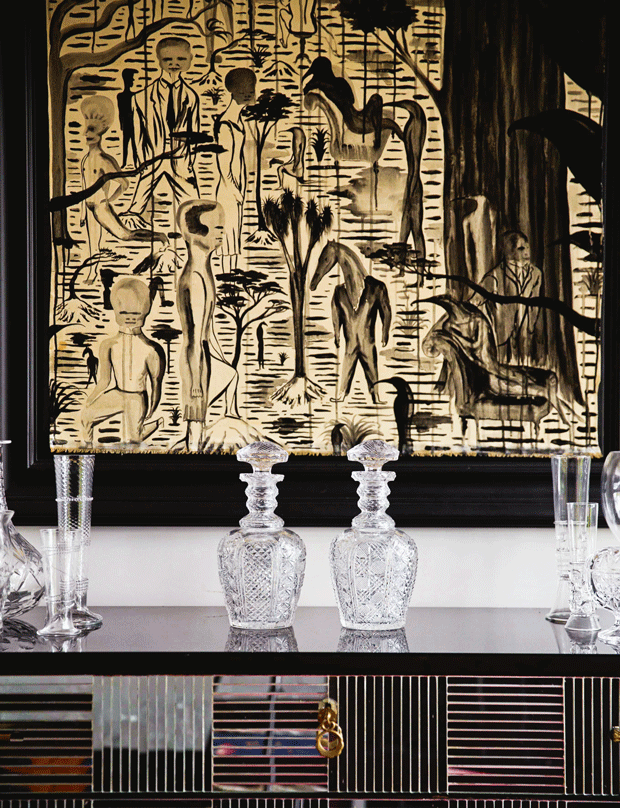
“The Christmas before last, the kids gave Robbie a day possum trapping with him. So they had to go out to help clear the traps – that was their gift to him. Alex decided she quite liked it,” says Liz.
The farm is certainly Liz and Rob’s balm. “We were aiming to spend 50 per cent of our time here this year, but we haven’t quite made it. But we’ll get there,” says Liz. “When I get to the country, I breathe out. Every single morning Robbie and I have breakfast on the verandah. We sit together for half an hour – we never do that in the city. We count the number of tui and we come up with amazing ideas, just sitting there.
“Then I’ll go off into the garden, and he’ll go off into the outer garden and we’ll meet for lunch. You’re busy all day and exhausted at the end. But it’s different. We can do all our business work and then go out into the garden. So it’s just lovely.”
THE COUNTRY GARDEN TO CITY PLATE
While the 70 hectares that surround the historic Riddiford House, on the Old Tablelands farm, is mostly bush, Liz has retained a good portion (0.2 hectares) for a vegetable garden and orchard. “It’s just massive. It’s all organic. We do have a full-time gardener and she boxes up what’s produced each week and sends it via same-day courier over the hill to Wellington.
“In February we can get six boxes a week, especially when the apples are coming off the trees. During those times of plenty I give a lot of it away. They don’t need to but I often get all sorts of things back – quince paste, crayfish, snapper, cakes, bread, even antique china. Sometimes we have so much produce I take it down to Harry’s and give it away to customers. Nothing is wasted.”
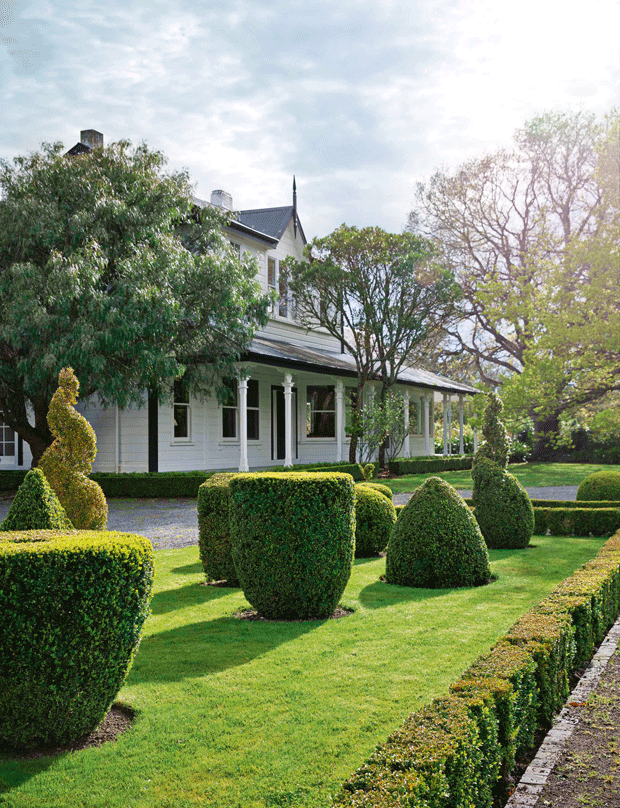
THE MOA CONSERVATION TRUST
Liz Stringer and Rob Morrison have several philanthropic causes, but top among them is the Moa Conservation Trust. As well as hosting the inaugural Wild Food Dinner to raise money for possum traps, together and separately they spend any spare time tramping through the bush clearing and resetting 15 kilometres of possum traps in the Rimutaka Forest Park.
“The idea is to make sure more of our native birds don’t go the way of the moa,” says Liz. “It takes about five hours to do one section. I usually go with a group of my girlfriends. We get a coffee from the Bizzy Lizzy Café in Wainuiomata – really good coffee – and drive into the Catchpool Valley. I wear gardening gloves and take a wooden spoon to push the possum out of the trap – some of them can be really manky. We record the dead possum, chuck it into the bush, and re-bait the trap.
“Rob and I like greenie stuff. We like birds. We like walking. So why not put it to some good use? We’re hiking anyway, might as well hike with a wooden spoon.”
Love this story? Subscribe now!
 This article first appeared in NZ Life & Leisure Magazine.
This article first appeared in NZ Life & Leisure Magazine.

